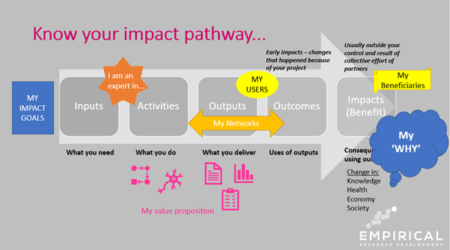In last week’s blog I noted that when it comes to measuring and demonstrating your impact, first you need to get clear on what impact you want to have.
This not only makes it much easier to plan a pathway towards it but when you get into the metrics and measuring of your impact, it means you’re measuring yourself against your goals and not somebody else’s…
As I have told many ECRs and graduate researchers, there are many ways to be a ‘successful’ researcher, but the other reality is, when you’re applying for academic jobs, applying for research grants, or applying for academic promotions, the metrics and measures of your publication, research and career impacts will be judged.
So as a graduate researcher, where do you start?
Once you know your worth, how do you show your worth?
Whether you want a career in academia or industry, promoting the expertise you want to be known for is a pretty good place to start. And as fraught as it might be, publishing (of books, journals, or other outputs) is the key mechanism to establish yourself as an expert in your field of research/knowledge.
And if you want others to know you’re an emerging expert, those outputs need to be discoverable.
If you’ve got good expertise and you let others know about it, the metrics should follow.
Understanding how those metrics are calculated, however, provides some clear steps to making them count.
Measuring your output impacts
There are two main types of output metrics, bibliometrics and altmetrics.
Bibliometrics are the traditional research metrics, or statistical analysis of publications, which are quantitative measures of a researcher, research team or institution’s publications.
This includes things like citations, Field Weighted Citation Impact (FWCI), the h-index, Journal impact factors and Journal rankings.
There are two main databases with their own tools for counting metrics. The Scopus database which has the SciVal tool (owned by Elsevier), and the Web of Science database which has the InCites tool (owned by Clarivate).
Altmetrics on the other hand, track where ‘published’ research is mentioned online – they provide qualitative information as well as metrics. The software text-mines what has been said about the research and covers sources such as social media, news stories, public policy, and patents.
The main aggregator for this is Altmetric Explorer but there is also Plum X (integrated into Elsevier’s products).
There are also four levels by which these metrics can be calculated:
- Article metrics, the metrics of individual scholarly outputs
- Journal metrics, and other venues of production such as publishing houses
- Author metrics, the metrics of an individual’s work
- Institution (or group) metrics, of a collection of authors
You can have a h-index for an author or a journal and a FWCI for an article or an author… either way, for your author and output metrics to be counted, both you and your work need unique object identifiers so the views, cites, or attention of the object are attributed to the authors.
Different tools (i.e. SciVal, InCites and Altmetric Explorer) will then allow you to produce evidence of your publication impact (the reach of your research and how it is being used) through their various metrics extracted from the Scopus, Web of Science or Altmetric databases.
Making it easy to attribute, find, count, and use your outputs
Knowing this means there are some key steps in making sure your metrics are attributed, found, counted, and used:
- Create a researcher/author profile
An ORCID iD is a 16-digit unique ID that means, even if you have a common name, or if you change your name (e.g. via marriage) your outputs (with their own unique identifiers) will always be attributed to you. Your ORCID iD can then be linked to a Scopus Author ID and a Web of Science ResearcherID so that the key databases count your work accurately.
- Pre-plan for publication impact
There are several things you can do before you even publish your paper to ensure it is found by the right people and has maximum impact.
Making sure you know your audience and target them, picking the right journal, choosing Open Access (where possible so outputs are Findable, Accessible, Interoperable and Reusable, for the global research ecosystem), making sure the keywords you use to describe your work match what someone will use in a search engine, making your article readable and accessible to all potential audiences (non-academic, interdisciplinary, etc).
- Actively share your research outputs with relevant networks
Once you’ve published then you can properly promote your work. Creating profiles on relevant research community repositories for your outputs (e.g. ResearchGate, Academia.edu, Mendeley, Figshare, GitHub, Dryad, Zenodo, ANDS, and many, many more… ) not only makes them accessible to specific scholarly networks relevant to your field, but starts to develop your online profile.
- Create a strong online profile to build your visibility
Developing a strong online presence will not only provide channels to disseminate your work but is a great way to build your visibility and networks. People want to work with great people – establishing a profile by promoting your work can lead to new collaborators or partnerships. You can do this in various ways:
- Make sure your institutional/Uni profile is up to date (if you have one)
- Create a LinkedIn account (think of it as a free webpage!)
- Create a Google Scholar profile (openly accessible to anyone, no accounts required!).
- Create a profile on social media (Twitter, Instagram, Facebook, You Tube, Tik Tok?!)
- Create a personal webpage if you have lots of content to share like a blog or podcast or videos…
Which channels you choose should take into account who you want to find and use your work…
- Communicate your research on social media
Social media, particularly Twitter, is increasingly being evidenced as a useful way to disseminate your research for impact. Social media offers researchers the opportunity to “push” your research out, rather than depending on other people to “pull” it in from academic publications. This often means broader audiences beyond academia too.
Depending on your intended audience, you might consider disseminating a Plain Language Statement (PLS) or other ‘enrichments’ rather than just your original research paper. Enrichments might include multimedia materials (podcasts, videos, slides, graphical summaries) which can boost engagement.
- Be ready to engage!
All this work to promote your research outputs will at some point (hopefully) end in engagement with your target audience. Whether that’s other researchers, professional associations, clinicians or practitioners, consumers, community groups or the general public, will you be ready to engage with them?
What would you say to a known research colleague or peer versus an unknown potential collaborator? What about a potential funding partner? What would you say to consumers or the general public versus the media?
Hopefully not your latest citation count!
Demonstrating your impact is not just about disseminating your research outputs and collecting metrics. Having a clear narrative and key messages about your research and career impact goals is essential to start building the foundations of your track record beyond your outputs.
Demonstrating your research impact – know your impact pathway
And this is where knowing your why and knowing your impact pathway comes back to the fore.
Along different parts of your research impact pathway should be the answers to the questions any stakeholder would want to know:
- for the colleague/peer… your expertise? What you need, who you’re working with?
- for the potential collaborator… shared impact goals? What you do – methods/approaches?
- for the potential funding partner… your value proposition?
- for consumers/patients… what you’re delivering, the outcomes/benefits?
- for the media… what you’re doing (generally), with who, for who, and why?

Demonstrating your career impact – know your impact pathway
For those of you that go on to an academic career, publications and research impact might be only part of your whole career’s impact. You might have impact through teaching. Or you might have impact through leadership roles in your organisation or your profession.
But what if you decide academic/research life isn’t for you?
The reason I like the input to impact logic model is that it doesn’t just work for research translation pathways.
Knowing what change you want to make in the world, and the why that drives it, will always need a plan of inputs, activities, and outputs to create outcomes.
It turns out, just like so many other aspects of a research degree, learning to measure and demonstrate your impact is a transferrable skill too.
Photo by Charlota Blunarova on Unsplash

